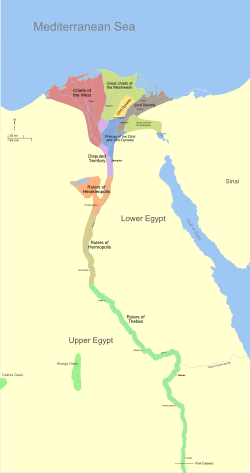Third Intermediate Period
| Third Intermediate Period of Egypt | ||||||||||
|
||||||||||
|
Political factions fractured ancient Egypt during the Third Intermediate Period. The boundaries above show the political situation during the mid-8th century BC.
|
||||||||||
| Capital |
|
|||||||||
| Languages | Ancient Egyptian | |||||||||
| Religion | Ancient Egyptian religion | |||||||||
| Government | Monarchy | |||||||||
| History | ||||||||||
| • | Established | c. 1069 BC | ||||||||
| • | Disestablished | c. 664 BC | ||||||||
|
||||||||||
| Today part of |
|
|||||||||
The Third Intermediate Period of Ancient Egypt began with the death of Pharaoh Ramesses XI in 1070 BC, ending the New Kingdom, and was eventually followed by the Late Period. Various points are offered as the beginning for the latter era, though it is most often regarded as dating from the foundation of the Twenty-Sixth Dynasty by Psamtik I in 664 BC, following the expulsion of the Nubian rulers of the Twenty-Fifth Dynasty by the Assyrians under King Assurbanipal.
The period was one of decline and political instability, coinciding with the Late Bronze Age collapse of civilizations in the Near East and Eastern Mediterranean (including the Greek Dark Ages). It was marked by division of the state for much of the period and conquest and rule by foreigners. But many aspects of life for ordinary Egyptians changed relatively little.
The period of the Twenty-First Dynasty is characterized by the country's fracturing kingship. Even in Ramesses XI's day, the Twentieth dynasty of Egypt was losing its grip on power in the city of Thebes, whose priests were becoming increasingly powerful. After his death, his successor Smendes I ruled from the city of Tanis, but was mostly active only in Lower Egypt which they controlled. Meanwhile, the High Priests of Amun at Thebes effectively ruled Middle and Upper Egypt in all but name. However, this division was less significant than it seems, since both priests and pharaohs came from the same family.
...
Wikipedia

